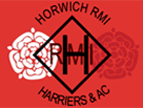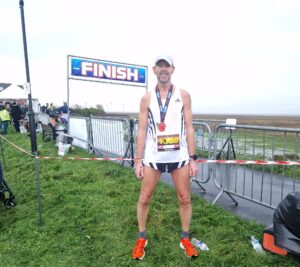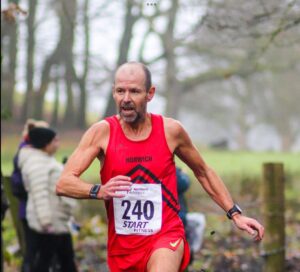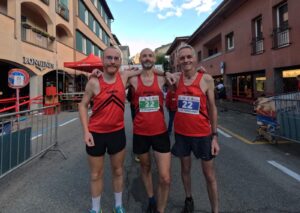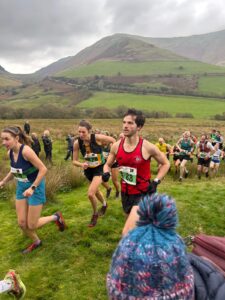History
The town of Horwich is synonymous with the railways. At the heart of the town the locomotive works provided employment for the majority of the men of Horwich until its demise in 1983. In May 1924 a group of enthusiasts formed the Railway Athletic Association on the railway works. They were known as the Horwich Railway Mechanic Institute, or simply the RMI.
So strong was the link with the railways that the club took its colours from the red of the engine and the black of the wheel trims. The red vest and black shorts are still used today. For many years only railway employees were allowed to join the Harriers with subscriptions deducted from their weekly pay. The club’s administrators were also employed as clerical staff on the works; however, this is no longer the case with the current membership coming from a wide catchment area.
Athletes just couldn’t afford the expense of travelling to fixtures, so open meetings were organised, usually on the site of the local cricket pitch – they were usually in the form of sprints.
Like most organisations, the Harriers relied heavily on its members. Fortunately they were blessed with a strong group of men. One man in particular was to have a huge impact on the club, John William Prescott, or Jack, was a leading runner of his time, a Northern champion. Jack was born in Adlington and joined Horwich just four months after its conception. He had a long and successful career before serving the club for a staggering thirty three years as club secretary. He then became Life President of the club. Jack also held various posts at both county and area level, but perhaps his greatest thrill was to be named as the official starter of the Bolton Marathon.
The Harriers first cross country course interestingly enough crossed the infamous Red Moss heath long before any talk of a super tip or even the M61 motorway. The club’s early fixtures consisted of paper trails over rough country in the winter, and grass track meetings in the summer months.
The club survived the depression of the 1930s, despite losing members due to redundancies. Worse was to follow with the death of several members in battle. After the war spirits were lifted when the annual Manchester to Blackpool relay passed through the town. The race, sponsored by the News of the World, was a major attraction, with many of the country’s leading athletes taking part. Sadly the race folded in the early sixties leaving a massive void in the racing calendar.
However, there is another race that is held dear to the heart of the people of Horwich. On Easter Saturday the crowds gather along Lever Park Avenue to await the spectacle of the Rivington Pike Fell race, the oldest established fell race in the country. It is usually won by an athlete of the highest calibre, with ex Olympians Ron Hill and Alan Blinston amongst the winners. But one man stands alone in the folklore of the Pike Race. TP Pat Campbell won nine out of the first ten races. His record of wins still stands but the fastest time was set in 1981 by John Wild, a track specialist, with a time of 15:53 in conditions that were described as perfect.
Since the war and up until the late sixties the membership base was relatively small, so much so that the senior men could be counted in single figures. The seventies saw the emergence of fell running predominantly in the North of England. This ensured a steady influx of new young members and one man in particular was destined to write a new chapter not only in the history of Horwich but also the history of British fell running.
Mike Short became British fell champion on two occasions. In so doing he rewrote the record books by breaking countless course records in most of the classic fell races of Britain. Mike’s success was the catalyst for a successful spell throughout the seventies.
However it was a completely different event that captured the imagination of the people of Britain and boosted the membership of every club in the land. The London Marathon created the running boom of the eighties and helped to launch Horwich RMI Harriers into a new phase that would prove to be the club’s most successful to date.
The large influx of new members, added to the strong base built up throughout the seventies, saw the club dominate the local athletics scene. On the road the club won the prestigious Tour of Tameside, and recorded a hat trick of wins in the Central Lancashire Grand Prix. These wins were duplicated on the country with Horwich being crowned champions of both the Red Rose and the South East Lancashire leagues.
The success at a domestic level transferred to the county championships with an historic first win in the Lancashire cross country championship. This win was made all the sweeter with Paul Dugdale taking the individual gold. Boundary changes enabled the club to add the Greater Manchester cross country championship to its growing list of successes. Individually several members gained county vests.
During this period Horwich members broke new ground by reaching a new level of performance. Paul Dugdale and later Martin Jones swept the board by winning County and Area titles. But it was their performance on the national stage that brought Horwich national prominence. Both athletes achieved a top ten British ranking amongst the leading distance runners in the country. They became the nucleus of a very strong Horwich team that qualified for the national championships in both the six and twelve stage road relays. In addition the clubs ranking soared from the mid two hundreds to twenty fifth at the English cross country championships.
In parallel with success on the road and country, the club’s fell section saw several members gain international selection to the annual world fell running championship. Martin Jones became the first Briton to win consecutive world titles. The club’s aspirations on the track were severely limited by the lack of facilities; this however didn’t stop both Dugdale and Jones landing county and area titles. Martin Jones gaining selection for the Great Britain team for the 1994 Commonwealth Games held in Victoria Canada. Martin finished a gallant fourth in the men’s ten thousand metres.
Dovetailed with the rise in fortunes of the senior men, the juniors and veterans began to blossom, culminating with both sections landing National team titles on the fells. Paul Murray, Norman Matthews, Tony Hesketh and Steve Jackson all became national veteran fell running champions.
The club gave great importance to involving all its membership, so, on two occasions they attempted to break the Pennine Way Relay Record covering two hundred and seventy miles. Although both attempts failed, the effect on morale enabled the club to launch a successful attempt on the Coast to Coast Record in 1993. The club then entered two teams of twenty one runners in the Welsh Castles Relay. They became the highest placed English club in the event’s history finishing a close second to the Welsh champions Swansea.
In April 2001 the Bolton Arena opened at Middlebrook in Horwich and with it the 6 lane running track that we had been developing and planning with Bolton Council Sports Development for over three years. This has provided the club with a track base at which the clubs athletes can develop their skills in what are the best facilities in the North West of England. The club’s senior athletes train at the track on Tuesday evenings and the sessions that are organised by the senior coach Norman Matthews have become so popular that many athletes from other clubs in the area are now training with the Harriers on these nights. The junior athletes meet on Monday and Thursday nights under the supervision of Steve Pearson and have become one of the most successful areas of the club.
In June 2002 as part of the Horwich Carnival a cycling race was held on closed roads around the town centre of Horwich. Among the many hundreds of spectators that day were a group of Horwich runners who thought if the road could be closed for cyclists then why not for runners. This thought lead what is now the “Tour of Horwich and Rivington”, a five race event held over 6 days. This series of races was the brainchild of Gareth Hughes, who has been our leading race organiser for many years. The five races in the Tour commence on Tuesday evening with the “Science in Sport” 6 mile trail race around the paths in Lever Park, Horwich. Wednesday is the Horwich Jubilee 4 mile road race sponsored by “On The Run”. Thursday sees the staging of the Walsh Shoes Two Lads Fell Race of approximately 5 miles. Friday is the Joseph Holt Brewery 4 mile cross country run in the splendid setting of Ridgmont Park, high on the slopes above the town of Horwich. The last race in the series is held on the Sunday and is a 5k race held on closed public roads around Horwich town centre. Gareth also introduced another 5k race on the Sunday whilst the roads were closed for the Carnival, and in 2003 this was selected to host the British Masters 5k road running championships. In 2004 Horwich were selected to host the North of England 5k road running Championships and was once again so successful that in 2005 we have been selected to host the AAA of England 5k championships.
